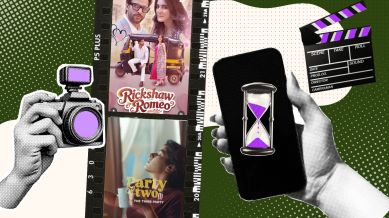Are micro-dramas the future of fiction?
The business of micro-dramas is a volume game, not a storytelling revolution, writes Jatin Varma, founder of Comic Con India

You know something’s up when the only successful thing about a new content format is the funding.
That’s where we are with micro-dramas in India.
monthly limit of free stories.
with an Express account.
Everyone’s saying the format is booming. Platforms are launching. Start-ups are raising rounds. Decks are full of stats from China and Southeast Asia.
But here’s the weird part: no one seems to be talking about the shows themselves. There are at least eight micro-drama platforms in India now: Kuku TV, Flick TV, Bullet, Pocket TV, and ReelSaga, among others, with regional slates in Tamil, Telugu, Kannada, Marathi, Bengali, you name it. You will find titles like Rickshaw Romeo, Chhayasongi, and Ade Kannu on app listings. There’s even a vertical-only platform called Bullet that claims to release 100+ episodes per week.
So the supply is definitely there.
But culturally? It’s quiet. There are no breakout moments; no characters people are quoting; no shows making their way into memes or group chats. Just press releases, LinkedIn updates, and some influencer-driven vertical content that feels more like branded entertainment than fiction.
We are building a content category before anyone’s sure they want to watch it.
Now I have worked in content for years, from non-fiction TV to fan conventions to way too many hours in edit rooms. I am also a full-time, mildly judgmental content consumer. I will give anything a shot, even if it looks doomed. Especially if it looks doomed.
And I have tried to watch micro-dramas. Not ironically. I actually gave it a go. Here’s what I got: extremely fast exposition, dramatic music, one-liner cliffhangers, and a vibe that sits somewhere between a soap opera, a reel, and an algorithm trying to guess what human emotions look like.
I understand the logic. They are cheap. They are easy to shoot. You don’t need big stars. You can target Tier 2–3 audiences who are watching everything on mobile anyway. You don’t need long attention. You just need repeat views.
But watching these shows doesn’t feel like watching anything. It feels like swiping past content you didn’t quite mean to open.
There’s a series called Party of Two that ran on Instagram, starring Nidhi Bhanushali and Sunakshi Grover, and was positioned as a micro-drama for the reel generation. And sure, it looked polished. But I didn’t hear anyone talk about it outside the platform itself. It came and went like most content made to ride a format wave.
This is what I keep wondering: is this a genre or a distribution trick?
Because everything about these shows feels like they were built backwards, starting from screen orientation and retention charts, then trying to wrap a story around that.
It’s not that people don’t want short content. They do. I have sat through hours of 3-minute cooking reels and Ghibli fan edits. But short doesn’t have to mean shallow.
The industry narrative is always some version of: “Attention spans are shrinking. This is what Gen Z wants. We are just meeting the moment.”
But let’s be honest. The shrinking attention span thing has become a convenient excuse to make forgettable content. You can’t binge-watch your way into quality. You can’t over-optimise a story and expect people to care.
Not every piece of content needs to be Prestige TV, but it shouldn’t feel like the rough cut of a WhatsApp forward, either. And it definitely shouldn’t be sold to creators as the new big thing when there’s barely a culture forming around it.
That said, the business will probably work. The margins are better. You can make a whole series for Rs 15 lakh, less than what one episode of a mid-tier web show used to cost. Platforms don’t need massive hits. They just need enough volume and enough regions to keep advertisers and investors happy.
That’s fine. But then let’s be clear: this is a volume game. Not a storytelling revolution.
The excitement shouldn’t be confused with impact. Because if I ask someone today to name a character, plotline, or moment from any Indian micro-drama they have seen in the last six months, they will either draw a blank or say, “I saw something with a rich guy and a pregnancy twist but I don’t remember the name.”
So no, I don’t think this is the future of fiction. It’s a format. A functional, scalable one. And maybe that’s enough. Not everything has to matter. But if we’re going to keep calling it a “revolution in storytelling,” we should at least be able to name one story.